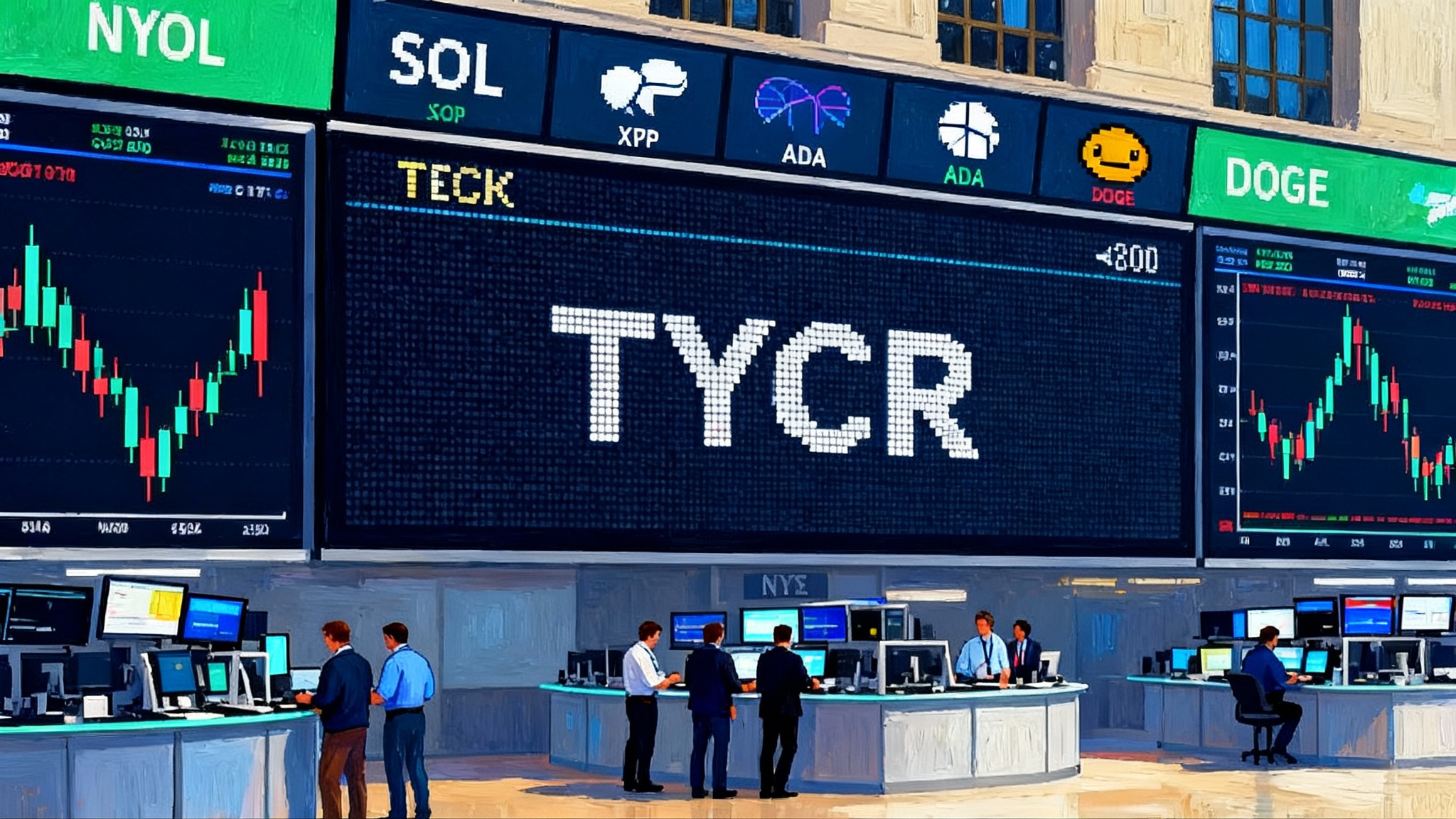Tether’s $500B bid and USA₮: the U.S. stablecoin reset
Reports on September 23-24 indicate Tether is seeking a $15-20 billion round at a near $500 billion valuation while readying USA₮, a U.S.-regulated dollar token. With Circle’s June IPO and a new federal stablecoin law, market share, transparency, and bank adoption could shift quickly.

A $500 billion question, asked in Washington time
Tether is reportedly exploring a private raise of $15-20 billion that could value the company near $500 billion. The news arrived alongside word that Tether is preparing a U.S.-regulated stablecoin called USA₮, a move that would push the world’s largest stablecoin issuer directly into the newly formal U.S. regime. See Reuters on the $500 billion valuation.
One day later, Tether named a new chief business officer, Benjamin Habbel, signaling a more enterprise-focused push as the firm diversifies beyond crypto into broader infrastructure bets.
A new U.S. chessboard: Circle’s IPO and a federal law
Circle, the USDC issuer, went public in early June 2025 on the NYSE under the ticker CRCL after upsizing its offering. On June 17, 2025, the Senate passed the GENIUS Act, the first federal framework for payment stablecoins. The bill then cleared the House and was signed into law on July 18, 2025. Among other things, it requires full reserve backing in cash and short-term Treasuries and mandates recurring public disclosures. These guardrails opened the door for banks, fintechs, and large retailers to issue or integrate stablecoins under federal standards.
With that backdrop, Tether’s U.S. pivot via USA₮ looks less like a side project and more like a strategic reconfiguration to compete head-on with USDC inside regulated U.S. rails.
The balance sheet behind the bid
Tether’s reserve disclosures show the firm as a large-scale Treasury investor, reporting more than $127 billion of U.S. Treasury exposure in mid 2025 and multibillion dollar quarterly profits largely driven by interest income. Academic work has begun to quantify the market impact of that demand, estimating that increases in T-bill share can nudge front-end yields. While the exact magnitude is debated, the direction is notable. If the raise prices anywhere near the headline valuation, it would reflect not only USDT’s cash generation in a high-rate world, but also investor belief that regulated distribution in the U.S. can magnify that engine. For context on tokenized cash and Treasuries, see our analysis of the Treasuries on Ethereum race.
On-chain reality check: supply, velocity, and usage
- Supply leadership. USDT’s circulating value sits near the low to mid $170 billions as of late September 2025, several times larger than any rival, while USDC is in the low to mid $70 billions. That gap defines the competitive baseline that USA₮ would need to climb if it comes to market in size.
- Turnover and velocity. Multiple data sets show USDT and USDC processing trillions per quarter in aggregate, with implied monthly turnover that is high by fiat standards. These adjusted, on-chain measures should be treated as directional, but they underline that stablecoins function as money-like instruments on public rails.
- Venue mix matters. USDC has been gaining share on centralized venues and in DeFi collateral, while USDT’s market cap continues to expand on off-exchange routes such as remittances and merchant settlement. Tron still carries the largest slice of USDT outstanding, with Ethereum hosting a significant but smaller portion.
The mosaic is a reminder that supply share is only part of the story. Velocity and venue mix tell you where dollars are actually moving and why those corridors matter for policy, consumer protection, and bank risk management.
What USA₮ adds that USDT does not
Tether says USA₮ will be issued within the U.S. under the GENIUS Act, with Anchorage Digital Bank as issuer and Cantor Fitzgerald as designated reserve custodian. The company frames the token as a compliance-forward product built for American businesses and institutions, separate from offshore-issued USDT. Read Tether unveils USA₮.
If executed as described, that structure brings three practical differences versus legacy offshore stablecoins:
- Regulated U.S. issuer obligations. Monthly reserve disclosures, asset-quality constraints, and mandated law-enforcement response capabilities align USA₮ with requirements that banks and large merchants expect in contracts.
- Banking-grade custody. A named custodian and a federally regulated issuer reduce counterparty ambiguity for corporate treasurers, card networks, and acquirers evaluating settlement risk.
- Distribution inside U.S. risk perimeters. USA₮ can be plugged into U.S. money-transmitter, broker-dealer, and bank vendor programs with fewer exceptions, which is how large-scale settlement actually rolls out in production.
Circle’s counter and the transparency bar
Circle’s IPO put a spotlight on disclosures, cash flows, and regulatory posture. Prospectus-era updates and subsequent quarterly reporting give public market style detail on reserves and revenue drivers, and the listing created a currency for acquisitions and partnerships. That transparency raises the bar for any competitor courting banks and Fortune 500 finance teams.
The policy tailwinds are also real. The GENIUS Act codifies reserve and disclosure norms and contemplates large-scale participation by banks and retailers, making it easier for compliance leaders to say yes once technical integration is done. For banks weighing stablecoins against other models, compare with tokenized deposits vs stablecoins.
Banks, retailers, and the next phase of dollar rails
With federal rules in place, bank and merchant adoption becomes a matter of commercials and integration.
- Banks. Expect regional and money-center banks to offer stablecoin settlement accounts, on-chain sweeps into T-bills, and intraday liquidity products. The value proposition is faster merchant settlement and lower interchange-like friction for certain payments. Early adopters will likely pilot with regulated stablecoins first because vendor risk, auditability, and freeze controls are straightforward to document.
- Retailers. Large retailers can issue closed-loop or co-branded stablecoin balances, settle supplier invoices on weekends, and streamline chargeback handling in certain rails. The law’s clarity on reserves and disclosures reduces reputational risk. Procurement teams will push for regulated issuers and bank-grade custody terms.
Adjacent experiments are expanding settlement options as well, including programmable enterprise rails such as NET Dollar for AI agents.
How market share could reset
Three forces will drive share through 2026: who wins regulated U.S. distribution, who sustains velocity in real commerce corridors, and who keeps the cleanest audit story.
- Regulated distribution. USA₮ and USDC both check the compliance box on paper. Execution will come down to contracting speed, wallet reach, and developer tooling across chains where mainstream traffic already lives. If Tether’s global network and custodian relationships convert quickly, USA₮ could seed material U.S. float without cannibalizing offshore USDT.
- Velocity in payments. Stablecoins already circulate at a pace that looks like working capital, not just trading collateral. The issuer that embeds deepest in commerce APIs and supplier platforms will convert that velocity into durable balances.
- Audits and reserves. Tether’s attestations and large Treasury stack are strengths, but USA₮ will be judged on U.S. law compliance and audit cadence. Circle’s public company reporting is a strong benchmark that procurement teams understand.
Scenarios to watch in Q4 2025
- Regulated two-rail world, rising tide
- What happens. USA₮ launches in controlled pilots with a top 10 acquirer and a few enterprise fintechs. USDC usage continues to grow on exchanges and in DeFi while deepening with U.S. banks. Offshore USDT keeps dominating remittances and crypto trading.
- Market effect. USDT supply stays near record highs, USDC inches higher, and USA₮ accumulates single-digit billions of float by year end. Velocity measures remain high as more non-trading payment flows land on chain.
- Why it sticks. Banks prefer to multisource for operational resilience and leverage in pricing, and retailers mirror that posture.
- USA₮ accelerates, USDC defends
- What happens. Tether converts relationships with exchanges, OTCs, and global PSPs into U.S. corridors faster than expected, helped by named custodian and issuer comfort. A few headline merchants add USA₮ rewards-balance options.
- Market effect. USA₮ vaults into the teens of billions in circulation, largely incremental to USDT. USDC defends share with banks and card networks, leaning on public company transparency to win treasury and procurement teams.
- Why it sticks. Distribution reach plus compliance by design is a potent combination when the law sets a common bar.
- Compliance drag, USDC consolidates
- What happens. USA₮ hits procedural delays, or audits surface issues that slow bank sign-offs. Merchants do not want to add a second token until there is demonstrated consumer demand.
- Market effect. USDC consolidates high-quality U.S. corridors and grows share on CEXs, while USDT remains dominant globally. USA₮ ends 2025 in limited pilots.
- Why it sticks. In regulated payments, slow is smooth and smooth is fast. Public company cadence plus a long audit trail is hard to beat.
The telltales that will settle the debate
- First bank and acquirer contracts naming USA₮, with service-level and freeze language spelled out.
- Reserve disclosure cadence for USA₮ and any third-party audit opinions beyond attestations.
- Exchange and on-chain wallet support that places USA₮ next to USDC in everyday U.S. flows.
- Chain-level distribution. Watch where USA₮ mints first, and whether it targets the chains where enterprise traffic already is.
- Velocity normalizing in payments-heavy corridors. If monthly turnover remains high outside trading venues, that is the strongest possible signal of mainstream adoption.
Bottom line
Tether’s reported raise and USA₮ plan are not mere headlines. They are a bid to translate offshore dominance into regulated U.S. distribution at the very moment a federal law has set the rules. Circle’s IPO and reporting cadence have already raised transparency expectations. If audits, banking integrations, and merchant distribution materialize in Q4, the stablecoin market could enter a second phase where scale and compliance converge. The dollars will still be digital. The difference will be who controls the pipes that move them.








